Abstract
Interest in the use of biological markers to evaluate future disease risk has increased greatly in recent years. Biomarkers are observable end points in a continuum of events leading from exposure to toxic agents to diseases that ultimately result from exposure. Because many significant diseases develop over long periods of time, methods for detecting early events that can predict risk are important for disease prevention. Biomarkers are generally categorized as detecting exposure, effects of exposure, or individual susceptibility to exposure. Although there has been significant progress in the technical development of biomarkers, implementation of their use in human populations has progressed much more slowly. We discuss four major needs in the development of biomarkers. First, new biomarkers need to be developed to fill gaps in our ability to observe steps in the continuum from exposure to disease. Second, the relationships between biomarker responses and disease pathology needs to be better understood. Third, the sensitivity, specificity, and variability of biomarkers need to be better characterized and they must be better validated as predictors of disease risk. Fourth, there are several societal impediments to the practical implementation of biomarker studies as public health tools. A common agreement among employers, employees, regulators, and the legal community must be established regarding appropriate and ethical uses and interpretation of biomarker data.
Full text
PDF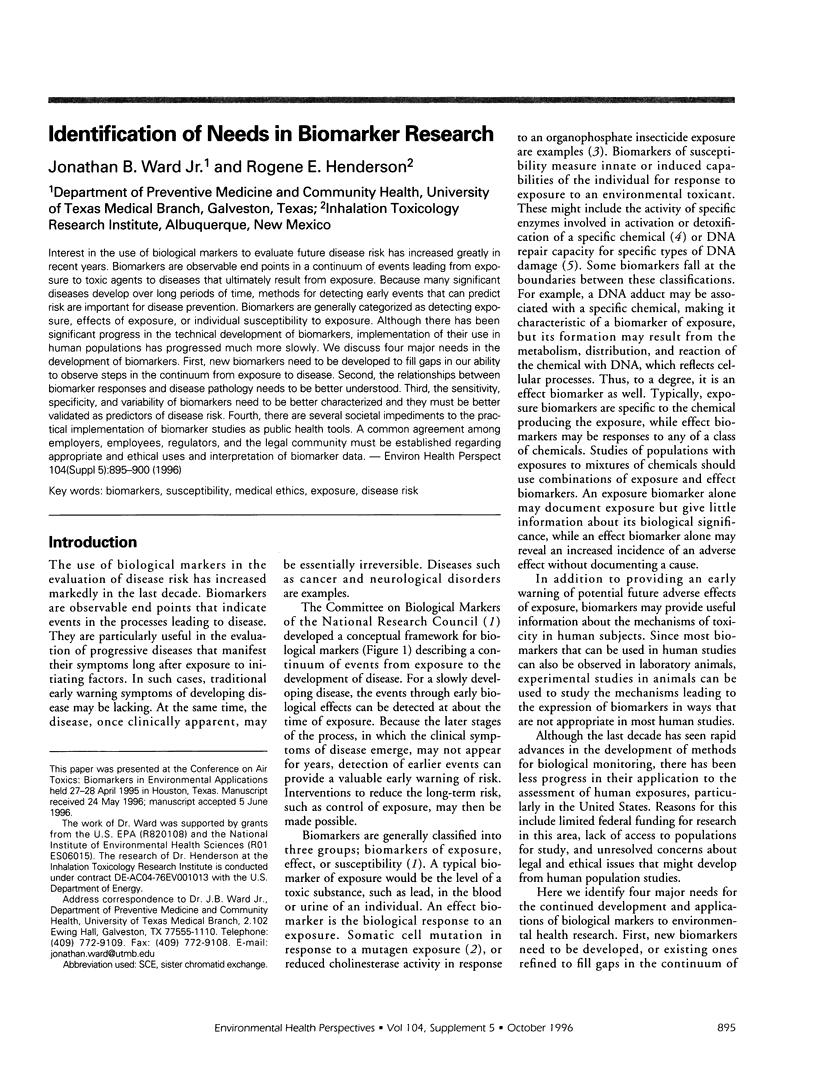

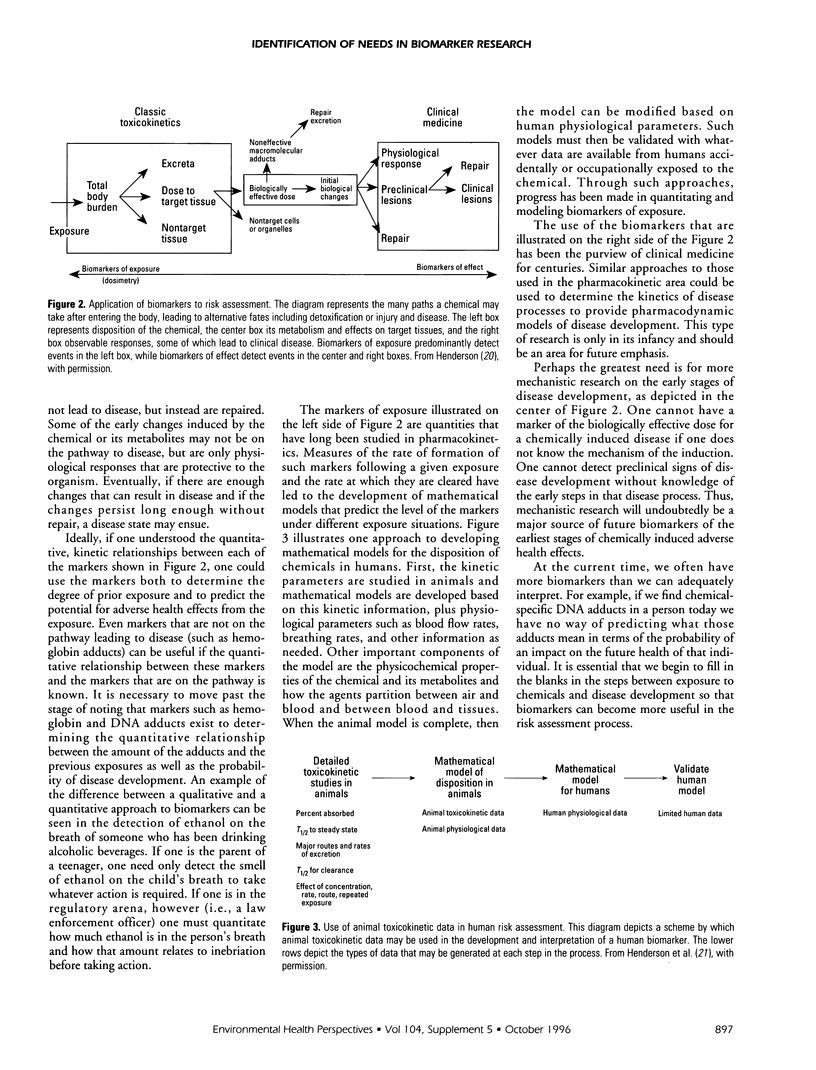
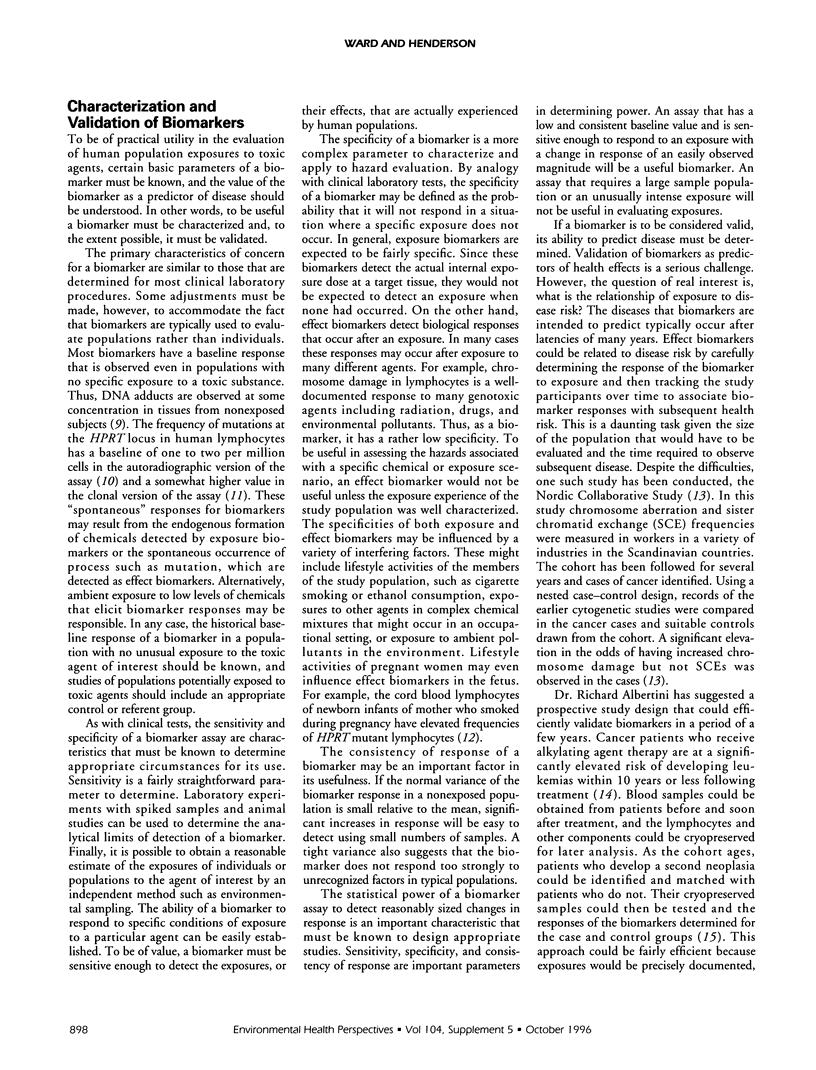
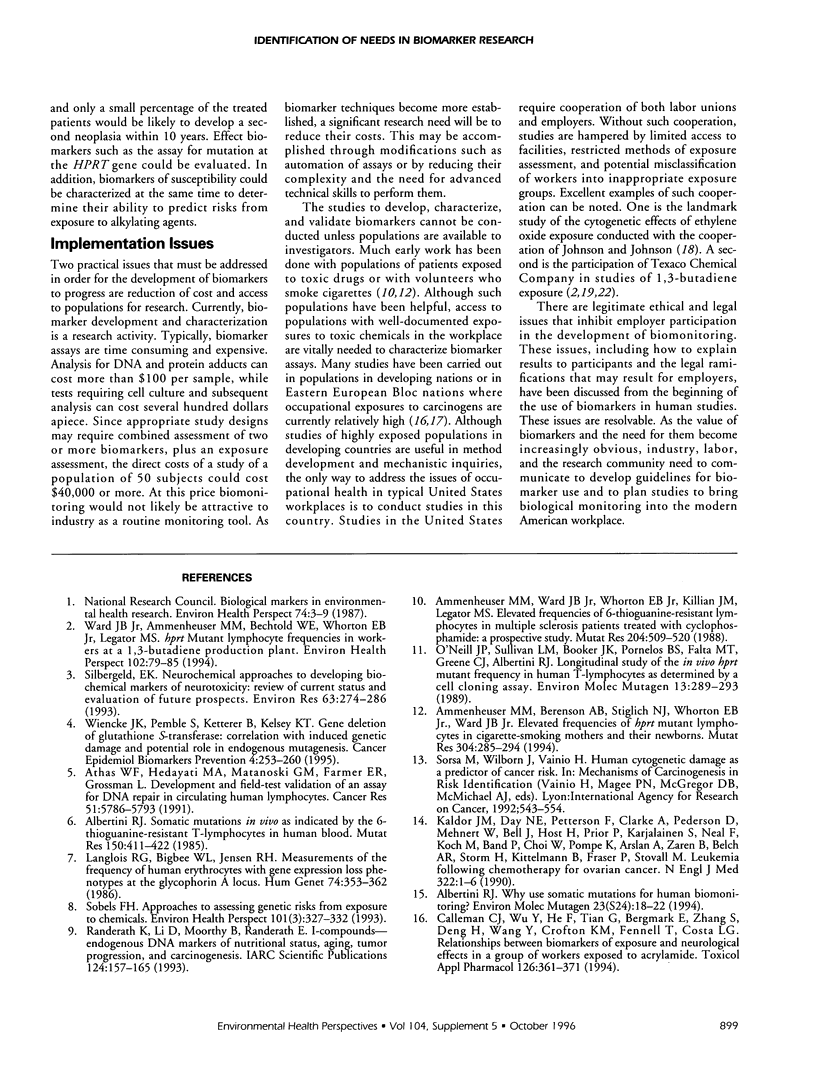
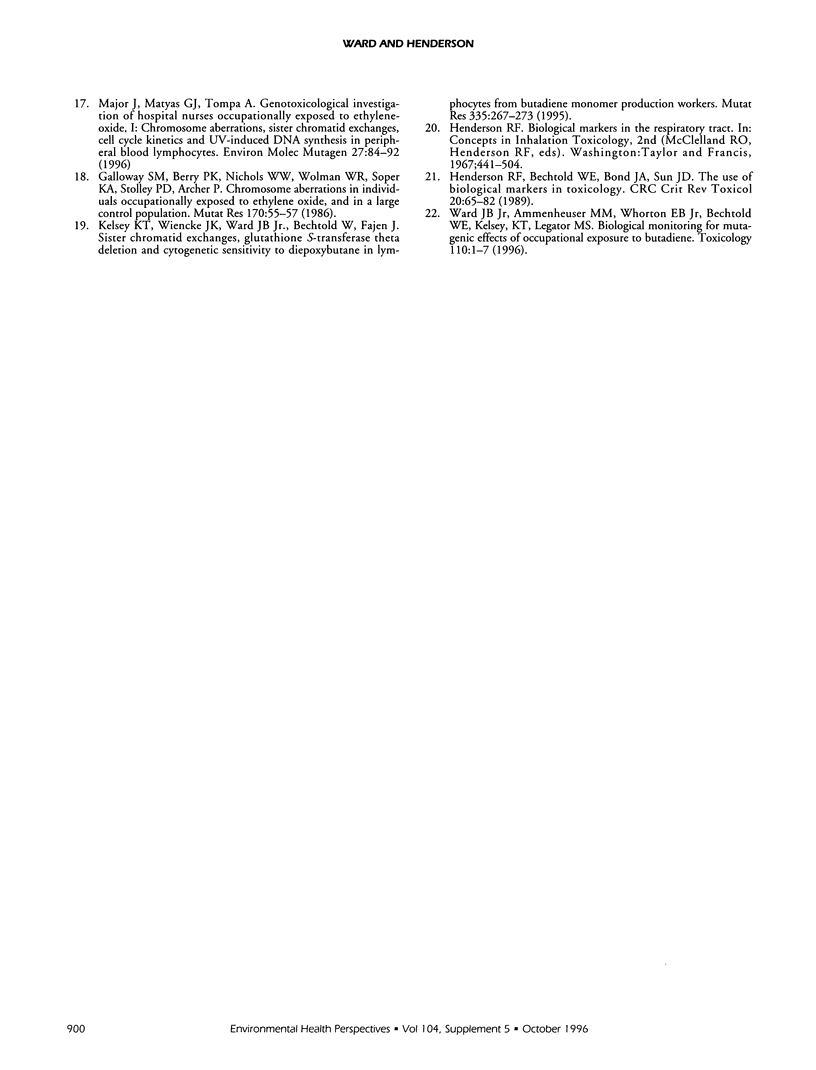
Selected References
These references are in PubMed. This may not be the complete list of references from this article.
- Albertini R. J. Somatic gene mutations in vivo as indicated by the 6-thioguanine-resistant T-lymphocytes in human blood. Mutat Res. 1985 Jun-Jul;150(1-2):411–422. doi: 10.1016/0027-5107(85)90138-1. [DOI] [PubMed] [Google Scholar]
- Albertini R. J. Why use somatic mutations for human biomonitoring? Environ Mol Mutagen. 1994;23 (Suppl 24):18–22. doi: 10.1002/em.2850230607. [DOI] [PubMed] [Google Scholar]
- Ammenheuser M. M., Berenson A. B., Stiglich N. J., Whorton E. B., Jr, Ward J. B., Jr Elevated frequencies of hprt mutant lymphocytes in cigarette-smoking mothers and their newborns. Mutat Res. 1994 Jan 16;304(2):285–294. doi: 10.1016/0027-5107(94)90221-6. [DOI] [PubMed] [Google Scholar]
- Ammenheuser M. M., Ward J. B., Jr, Whorton E. B., Jr, Killian J. M., Legator M. S. Elevated frequencies of 6-thioguanine-resistant lymphocytes in multiple sclerosis patients treated with cyclophosphamide: a prospective study. Mutat Res. 1988 Mar;204(3):509–520. doi: 10.1016/0165-1218(88)90045-6. [DOI] [PubMed] [Google Scholar]
- Athas W. F., Hedayati M. A., Matanoski G. M., Farmer E. R., Grossman L. Development and field-test validation of an assay for DNA repair in circulating human lymphocytes. Cancer Res. 1991 Nov 1;51(21):5786–5793. [PubMed] [Google Scholar]
- Calleman C. J., Wu Y., He F., Tian G., Bergmark E., Zhang S., Deng H., Wang Y., Crofton K. M., Fennell T. Relationships between biomarkers of exposure and neurological effects in a group of workers exposed to acrylamide. Toxicol Appl Pharmacol. 1994 Jun;126(2):361–371. doi: 10.1006/taap.1994.1127. [DOI] [PubMed] [Google Scholar]
- Galloway S. M., Berry P. K., Nichols W. W., Wolman S. R., Soper K. A., Stolley P. D., Archer P. Chromosome aberrations in individuals occupationally exposed to ethylene oxide, and in a large control population. Mutat Res. 1986 Apr-May;170(1-2):55–74. doi: 10.1016/0165-1218(86)90082-0. [DOI] [PubMed] [Google Scholar]
- Henderson R. F., Bechtold W. E., Bond J. A., Sun J. D. The use of biological markers in toxicology. Crit Rev Toxicol. 1989;20(2):65–82. doi: 10.3109/10408448909017904. [DOI] [PubMed] [Google Scholar]
- Kaldor J. M., Day N. E., Pettersson F., Clarke E. A., Pedersen D., Mehnert W., Bell J., Høst H., Prior P., Karjalainen S. Leukemia following chemotherapy for ovarian cancer. N Engl J Med. 1990 Jan 4;322(1):1–6. doi: 10.1056/NEJM199001043220101. [DOI] [PubMed] [Google Scholar]
- Kelsey K. T., Wiencke J. K., Ward J., Bechtold W., Fajen J. Sister-chromatid exchanges, glutathione S-transferase theta deletion and cytogenetic sensitivity to diepoxybutane in lymphocytes from butadiene monomer production workers. Mutat Res. 1995 Dec;335(3):267–273. doi: 10.1016/0165-1161(95)00030-5. [DOI] [PubMed] [Google Scholar]
- Langlois R. G., Bigbee W. L., Jensen R. H. Measurements of the frequency of human erythrocytes with gene expression loss phenotypes at the glycophorin A locus. Hum Genet. 1986 Dec;74(4):353–362. doi: 10.1007/BF00280485. [DOI] [PubMed] [Google Scholar]
- Major J., Jakab M. G., Tompa A. Genotoxicological investigation of hospital nurses occupationally exposed to ethylene-oxide: I. Chromosome aberrations, sister-chromatid exchanges, cell cycle kinetics, and UV-induced DNA synthesis in peripheral blood lymphocytes. Environ Mol Mutagen. 1996;27(2):84–92. doi: 10.1002/(SICI)1098-2280(1996)27:2<84::AID-EM2>3.0.CO;2-E. [DOI] [PubMed] [Google Scholar]
- O'Neill J. P., Sullivan L. M., Booker J. K., Pornelos B. S., Falta M. T., Greene C. J., Albertini R. J. Longitudinal study of the in vivo hprt mutant frequency in human T-lymphocytes as determined by a cell cloning assay. Environ Mol Mutagen. 1989;13(4):289–293. doi: 10.1002/em.2850130403. [DOI] [PubMed] [Google Scholar]
- Olin K. L., Cherr G. N., Rifkin E., Keen C. L. The effects of some redox-active metals and reactive aldehydes on DNA-protein cross-links in vitro. Toxicology. 1996 Jun 17;110(1-3):1–8. doi: 10.1016/0300-483x(96)03318-5. [DOI] [PubMed] [Google Scholar]
- Randerath K., Li D., Moorthy B., Randerath E. I-compounds--endogenous DNA markers of nutritional status, ageing, tumour promotion and carcinogenesis. IARC Sci Publ. 1993;(124):157–165. [PubMed] [Google Scholar]
- Silbergeld E. K. Neurochemical approaches to developing biochemical markers of neurotoxicity: review of current status and evaluation of future prospects. Environ Res. 1993 Nov;63(2):274–286. doi: 10.1006/enrs.1993.1147. [DOI] [PubMed] [Google Scholar]
- Sobels F. H. Approaches to assessing genetic risks from exposure to chemicals. Environ Health Perspect. 1993 Oct;101 (Suppl 3):327–332. doi: 10.1289/ehp.93101s3327. [DOI] [PMC free article] [PubMed] [Google Scholar]
- Ward J. B., Jr, Ammenheuser M. M., Bechtold W. E., Whorton E. B., Jr, Legator M. S. hprt mutant lymphocyte frequencies in workers at a 1,3-butadiene production plant. Environ Health Perspect. 1994 Nov;102 (Suppl 9):79–85. doi: 10.1289/ehp.94102s979. [DOI] [PMC free article] [PubMed] [Google Scholar]
- Wiencke J. K., Pemble S., Ketterer B., Kelsey K. T. Gene deletion of glutathione S-transferase theta: correlation with induced genetic damage and potential role in endogenous mutagenesis. Cancer Epidemiol Biomarkers Prev. 1995 Apr-May;4(3):253–259. [PubMed] [Google Scholar]


